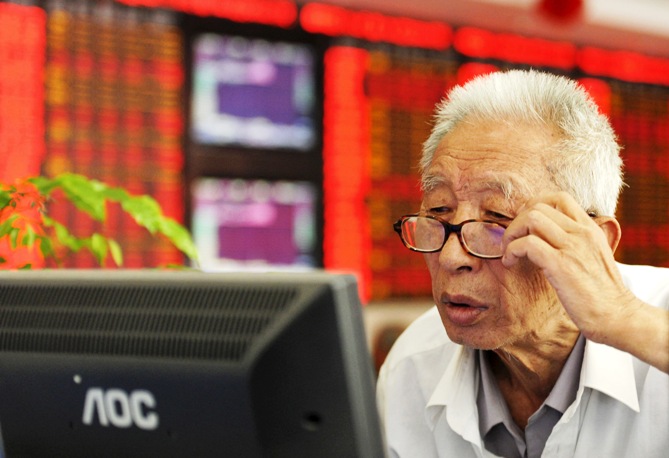 | « Back to article | Print this article |
 Indian market less exposed to cyclicals; defensives account for 31.1% of BSE 200, against 20.8% in China’s CIS 300
Indian market less exposed to cyclicals; defensives account for 31.1% of BSE 200, against 20.8% in China’s CIS 300
There is little possibility of a Chinese-style rout on Dalal Street, owing to a basic difference in the structure of the two markets.
The Indian stock market is less exposed to high-beta and cyclical sectors and has higher exposure to defensives than the Chinese stock market.
Financials, the biggest cyclical sector, accounts for 27.8 per cent of the Indian stock market, against 42 per cent in China.
In all, cyclical stocks such as those from the banks & financials, energy, metal & mining and capital goods & construction segments have 53 per cent weight in India, against 68.6 per cent in China.
By comparison, defensives, including fast-moving consumer goods, infotech and pharma and health care, account for 31.1 per cent of Indian stock indices, against 20.8 per cent in the Chinese market.
Tata Consultancy Services is the most valuable company on Dalal Street, while ITC has the highest weight on the BSE 200 index.
Across the border, Petro China is the most valuable company, while Ping An Insurance Group has the highest weigh in the CIS 300 index.
The analysis is based on the current free-float market capitalisation of the respective companies in the BSE 200 and the Shanghai Shenzhen CIS 300 indices (an index of the top 300 stocks from China’s two primary stock exchanges -- Shanghai and Shenzhen).
A higher weight of defensives stocks such as TCS, Infosys, ITC, Hindustan Unilever and Sun Pharma limit the downside risk for Dalal Street, as information technology, FMCG and pharma companies are less sensitive to movements in the broader market.
“In a broader market sell-off, defensive stocks react the least and provide support to the indices, while the fall is led by rate-sensitives such as financials, metals and capital good stocks,” says G Chokkalingam, founder and chief executive, Equinomics Research & Advisory.
The weight of the metal sector, which has high linkages to China, has fallen to less than five per cent, down from about 15 per cent at one point. The low weight of metals and commodities also help the Indian market insulate itself from turmoil in China.
This might partly explain the contrasting movements in the two markets.
“Historically, the correlation between Indian and Chinese markets has been low or negative.
"In the past few days, there was significant news flow, which saw both markets fall.
"But the reaction on Dalal Street has been muted compared to what we saw in Shanghai,” says Sandip Sabharwal, an independent stock market analyst.
“The reason China has high weight of cyclicals is its market has entered a bubble territory.
If our market also sees similar exuberance, the weight of cyclical will go up here, too.
The reason defensives have a high weight here is our market hasn’t entered a bubble zone,” says Saurabh Mukherjea, chief executive (institutional equities) at Ambit Capital.
In many ways, the structure of the Chinese market is reminiscent of Dalal Street at the end of 2007. On the eve of the 2008 stock market crash, the BSE 200 was largely dominated by high-beta stocks, with defensives playing only a marginal role.
At the end of 2007, cyclicals accounted for 68 per cent of the BSE 200’s free-float market capitalisation and the share of defensives was only 16.6 per cent, half of their current weight.
Unsurprisingly, the Indian market melted, as the stocks of banks, energy companies and metals and industrial firms fell sharply in the wake of the 2008 Lehman Brothers’ collapse.
At that time, companies such as Infosys, TCS, ITC, Hindustan Unilever, Sun Pharma and Dr. Reddy’s were too small (in terms of market capitalisation) to compensate for the losses recorded by high-beta names such as Reliance Industries, L&T, BHEL, State Bank of India, Tata Steel and Tata Motors.
Now, the situation is different.
There are four defensive companies among the 10 most valuable stocks on Dalal Street, including TCS.
The risk to the Indian market is from its higher valuation and the historically higher share of financials, especially private sector banks, in the benchmark indices.
The price-to-earnings multiple of Indian markets is high, compared to other global markets, including China,” says Sabharwal.
This is partly due to the higher weigh of defensives, which are high-return (in terms of return on equity) and zero-debt companies.
This leads to investors willing to pay a premium to own and hold these.
Image: An investor adjusts his glasses as he looks at a computer screen in front of an electronic board showing stock information at a brokerage house in Fuyang, Anhui province, China, July 9, 2015. Photograph: China Daily/Reuters